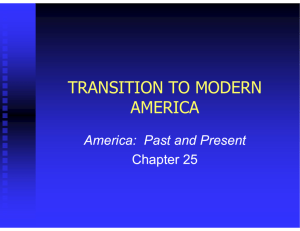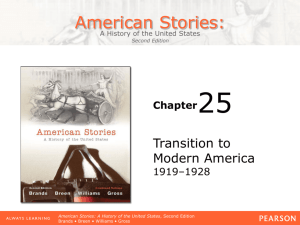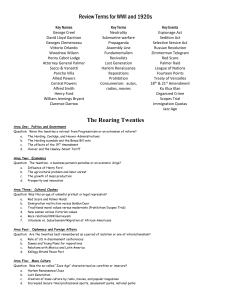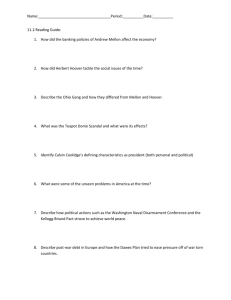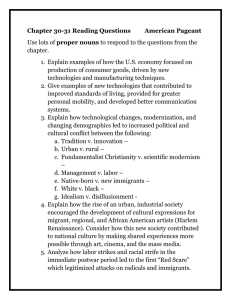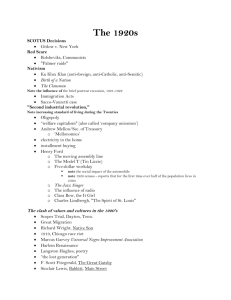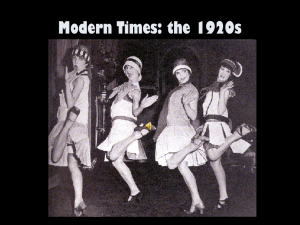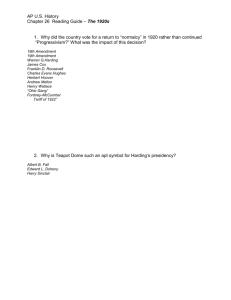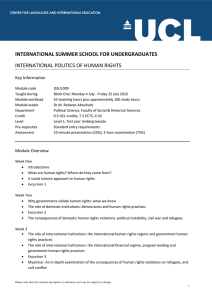CHAPTER 25 TRANSITION TO MODERN AMERICA
advertisement
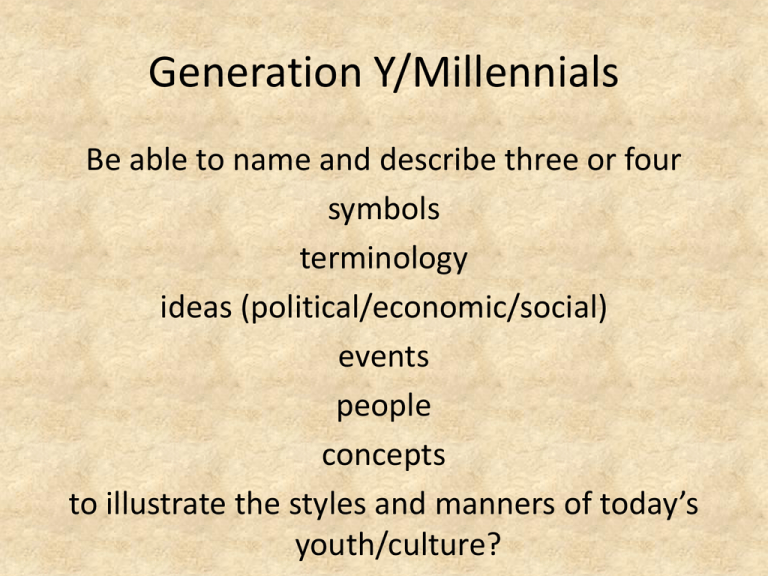
Generation Y/Millennials Be able to name and describe three or four symbols terminology ideas (political/economic/social) events people concepts to illustrate the styles and manners of today’s youth/culture? Group Questions One Individual needs to be the spokesperson of the group (Choose a side!!!!) • Group 1=Politics and Government: Were the 20’s a retreat from Progressivism or an extension of reform? • Group 2=Economics: Were the 20’s a business paradise or an economic black hole? • Group 3=Cultural Clashes: Was this an age of unlawful protest or legal repression? • Group 4=Diplomacy and Foreign Affairs: Are the 20’s best remembered as a period of isolation or one of internationalism? • Group 5=Mass Culture: Was the so-called “Jazz Age” characterized as carefree or insecure? 1. What similarities do you see between the images? 2. What differences do you see between the images? 3. What conflict is being suggested by the images? Edward Hopper, Automat, 1927 John Sloan, 6th Ave Elevated, 1928 TRANSITION TO MODERN AMERICA Chapter 25 Patterns of Economic Growth • Second Industrial Revolution – Electricity replaced steam – Modern assembly introduced • New technologies meant new industries and business – Examples: automobiles, radio, motion pictures, marketing, advertising, etc… – Big business weakened regionalism, brought uniformity to America • U.S. developed the highest standard of living in the world Economic Weaknesses • • • • Railroads poorly managed Coal displaced by petroleum Farmers faced decline in exports, prices Growing disparity between income of laborers, middle-class managers • Middle class speculating with money (stock market) Change in Cultural Life • City Life in the Jazz Age – Harlem Renaissance-African Americans prominent in music, poetry • Rapid increase in urban population – Skyscrapers symbolized the new mass culture – Communities of home, church, and school were absent in the cities • Decade was notable for obsessive interest in celebrities and sports – Celebrities -Charles Lindbergh, Gertrude Ederle – Sports-Jack Dempsey, Babe Ruth, etc… • Women starting to challenge conformity (equal rights) – Flapper Girls (minority) – Sexual revolution • 1925: Scopes Trial discredited fundamentalism among intellectuals – Fundamentalists vs. Modernists • "Exiled" American writers put U.S. in forefront of world literature – They were bewildered by the rapid changing social patterns and appalled by the materialism of America as well as the wastefulness of WWI – T.S. Eliot, Ernest Hemingway, F. Scott Fitzgerald, etc… The Rural Counterattack • Rural Americans identified urban culture with Communism, crime, immorality • Progressives attempted to force reform on the American people – Upsurge of bigotry – An era of repression Red Scare • 1919: “Red Scare” – – – – Illegal roundups of innocent people Forcible deportation of aliens Terrorism against “radicals,” immigrants Sacco and Vanzetti executed • 1925: Klan membership hit 5 million – Violence, internal corruption resulted in Klan’s virtual disappearance by 1930 • 1924: National Origins Act – Quotas favored northern Europeans – Mexican immigrants exempted from quota Prohibition • 18th Amendment gave federal government power to pass Volstead Act of 1920 that prohibits production, sale, or transport of alcoholic beverages • Consumption of alcohol reduced • Prohibition resented in urban areas • Bootlegging became big business (crime increases) Harding, Coolidge, and Hoover • Return to "normalcy" – – – – Tariffs raised Corporate, income taxes cut Spending cut Government-business cooperation • Republican presidents appealed to traditional American values • Coolidge represented America in his austerity and rectitude • Hoover represented the self-made man • Urban wing of the Democratic party emerged as the most powerful force – Still divided between rural and urban democrats The Old and the New • Old historical view: The Depression ended the spirit of the twenties • New historical view: The twenties laid the foundations of modern America
